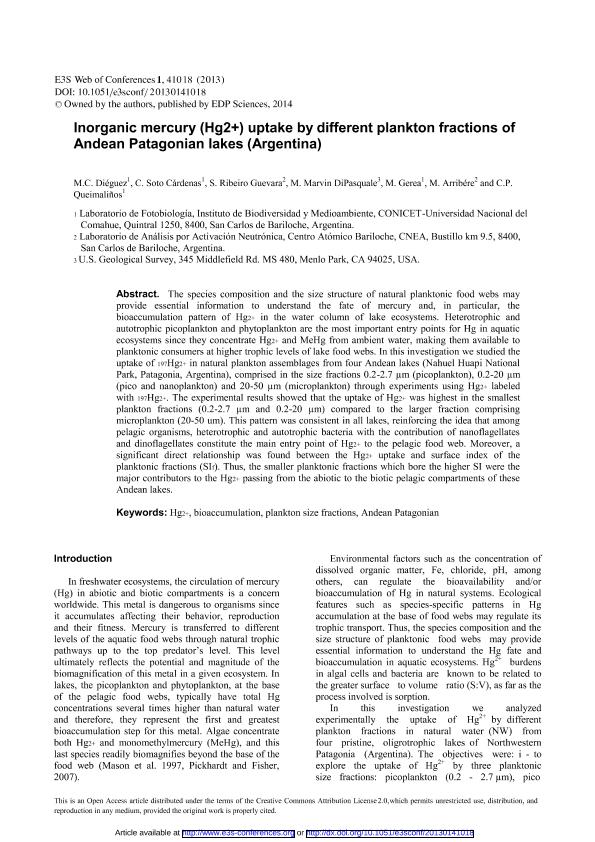Mostrar el registro sencillo del ítem
dc.contributor.author
Dieguez, Maria del Carmen

dc.contributor.author
Soto Cárdenas, Carolina
dc.contributor.author
Ribeiro Guevara, Sergio
dc.contributor.author
Dipasquale, Mark Marvin
dc.contributor.author
Gerea, Marina

dc.contributor.author
Arribére, María
dc.contributor.author
Queimaliños, Claudia Patricia

dc.date.available
2016-07-29T16:25:30Z
dc.date.issued
2013-07
dc.identifier.citation
Dieguez, Maria del Carmen; Soto Cárdenas, Carolina; Ribeiro Guevara, Sergio; Dipasquale, Mark Marvin; Gerea, Marina; et al.; Inorganic mercury (Hg2+) uptake by different plankton fractions of Andean Patagonian lakes (Argentina); EDP Sciences; E3S Web Conferences; 1; 4101; 7-2013; 1-4
dc.identifier.issn
2100-014X
dc.identifier.uri
http://hdl.handle.net/11336/6808
dc.description.abstract
The species composition and the size structure of natural planktonic food webs may provide essential information to understand the fate of mercury and, in particular, the bioaccumulation pattern of Hg2+ in the water column of lake ecosystems. Heterotrophic and autotrophic picoplankton and phytoplankton are the most important entry points for Hg in aquatic ecosystems since they concentrate Hg2+ and MeHg from ambient water, making them available to planktonic consumers at higher trophic levels of lake food webs. In this investigation we studied theuptake of 197Hg2+ in natural plankton assemblages from four Andean lakes (Nahuel Huapi National Park, Patagonia, Argentina), comprised in the size fractions 0.2-2.7 µm (picoplankton), 0.2-20 µm (pico and nanoplankton) and 20-50 µm microplankton) through experiments using Hg2+ labeled with 197Hg2+. The experimental results showed that the uptake of Hg2+ was highest in the smallest plankton fractions (0.2-2.7 µm and 0.2-20 µm) compared to the larger fraction comprising microplankton (20-50 um). This pattern was consistent in all lakes, reinforcing the idea that among pelagic organisms, heterotrophic and autotrophic bacteria with the contribution of nanoflagellates and dinoflagellates constitute the main entry point of Hg2+ to the pelagic food web. Moreover, a significant direct relationship was found between the Hg2+ uptake and surface index of the planktonic fractions (SIf). Thus, the smaller planktonic fractions which bore the higher SI were the major contributors to the Hg2+ passing from the abiotic to the biotic pelagic compartments of these Andean lakes.
dc.format
application/pdf
dc.language.iso
eng
dc.publisher
EDP Sciences

dc.rights
info:eu-repo/semantics/openAccess
dc.rights.uri
https://creativecommons.org/licenses/by/2.5/ar/
dc.subject
Mercury
dc.subject
Bioaccumulation
dc.subject
Plankton Size Fractions
dc.subject
Andean Patagonian Lakes
dc.subject.classification
Oceanografía, Hidrología, Recursos Hídricos

dc.subject.classification
Ciencias de la Tierra y relacionadas con el Medio Ambiente

dc.subject.classification
CIENCIAS NATURALES Y EXACTAS

dc.title
Inorganic mercury (Hg2+) uptake by different plankton fractions of Andean Patagonian lakes (Argentina)
dc.type
info:eu-repo/semantics/article
dc.type
info:ar-repo/semantics/artículo
dc.type
info:eu-repo/semantics/publishedVersion
dc.date.updated
2016-07-28T18:34:10Z
dc.journal.volume
1
dc.journal.number
4101
dc.journal.pagination
1-4
dc.journal.pais
Francia

dc.description.fil
Fil: Dieguez, Maria del Carmen. Consejo Nacional de Investigaciones Científicas y Técnicas. Centro Científico Tecnológico Patagonia Norte. Instituto de Investigación En Biodiversidad y Medioambiente; Argentina
dc.description.fil
Fil: Soto Cárdenas, Carolina. Consejo Nacional de Investigaciones Científicas y Técnicas. Centro Científico Tecnológico Patagonia Norte. Instituto de Investigación En Biodiversidad y Medioambiente; Argentina
dc.description.fil
Fil: Ribeiro Guevara, Sergio. Comision Nacional de Energia Atomica. Gerencia D/area de Energia Nuclear. Unidad de Actividad de Ingenieria Nuclear. Laboratorio de Analisis Por Activacion Neutronica; Argentina
dc.description.fil
Fil: Dipasquale, Mark Marvin. United States Geological Survey; Estados Unidos
dc.description.fil
Fil: Gerea, Marina. Consejo Nacional de Investigaciones Científicas y Técnicas. Centro Científico Tecnológico Patagonia Norte. Instituto de Investigación En Biodiversidad y Medioambiente; Argentina
dc.description.fil
Fil: Arribére, María. Comision Nacional de Energia Atomica. Gerencia D/area de Energia Nuclear. Unidad de Actividad de Ingenieria Nuclear. Laboratorio de Analisis Por Activacion Neutronica; Argentina
dc.description.fil
Fil: Queimaliños, Claudia Patricia. Consejo Nacional de Investigaciones Científicas y Técnicas. Centro Científico Tecnológico Patagonia Norte. Instituto de Investigación En Biodiversidad y Medioambiente; Argentina
dc.journal.title
E3S Web Conferences
dc.relation.alternativeid
info:eu-repo/semantics/altIdentifier/url/http://www.e3s-conferences.org/articles/e3sconf/abs/2013/01/e3sconf_ichmet2013_41018/e3sconf_ichmet2013_41018.html
dc.relation.alternativeid
info:eu-repo/semantics/altIdentifier/doi/http://dx.doi.org/10.1051/e3sconf/20130141018
dc.relation.alternativeid
info:eu-repo/semantics/altIdentifier/doi/10.1051/e3sconf/20130141018
dc.relation.alternativeid
info:eu-repo/semantics/altIdentifier/url/https://doaj.org/article/8721b7855e4d4f3c812e4f4df62da9f3
Archivos asociados
